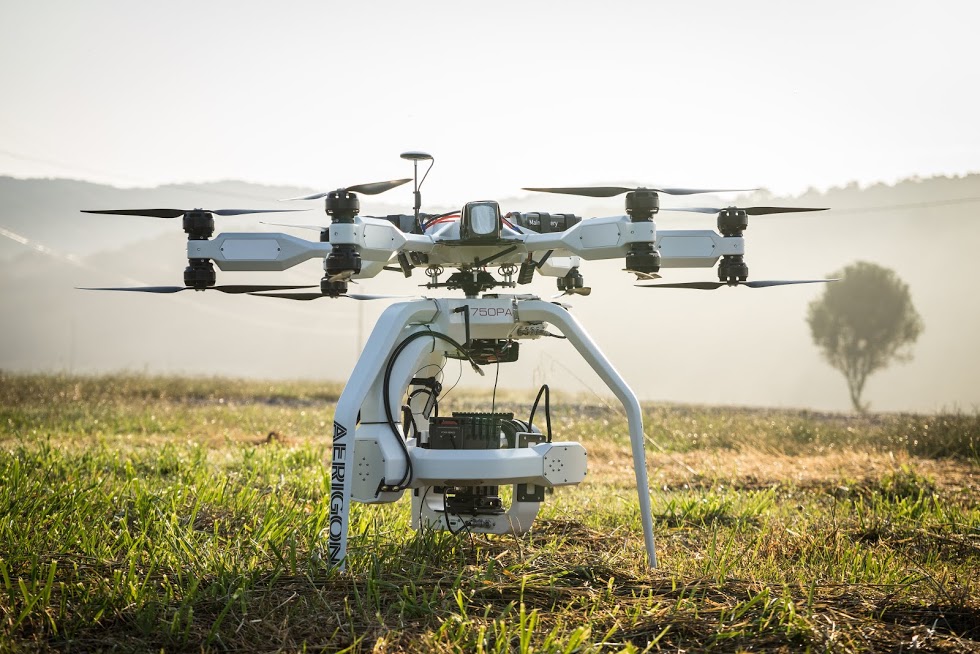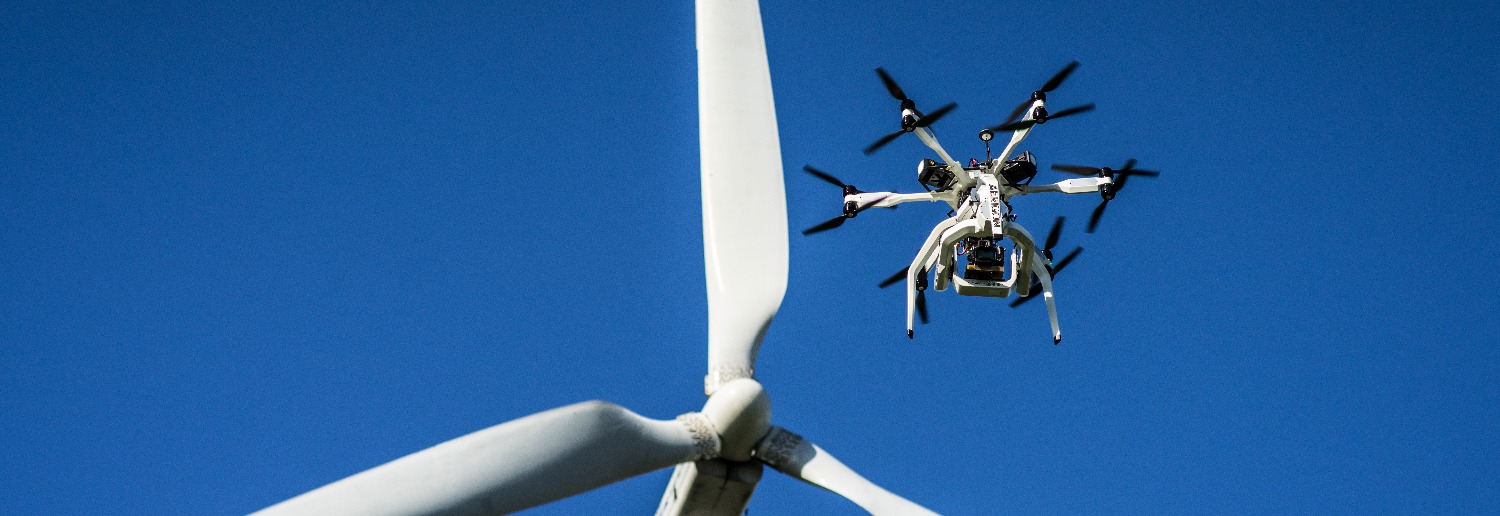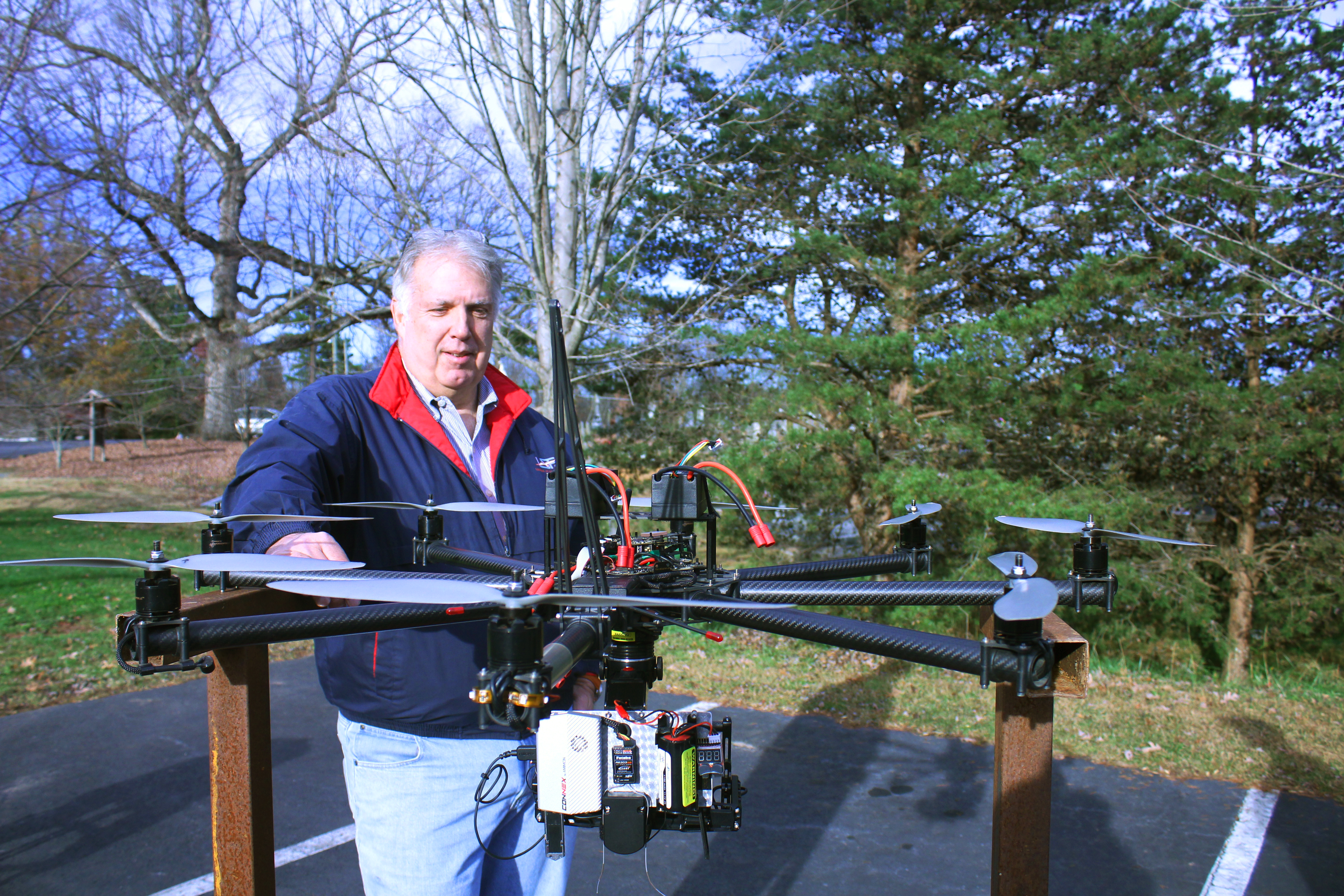
The Strong Growth of Drone Operators Working in Film & TV Production
“The way you can tell how a drone pilot is feeling is to look at his feet,” says Tim Foster, as the eight propellers of his CineStar-8 Quadrocopter chirp like a chorus of birds and start to spin. “If he’s relaxed and still, like this, it means everything’s okay. If he’s shuffling around, like this, it means something might be off. And if he starts running…RUN!”

Foster gives a hearty laugh as he maneuvers the drone off the hands of his media consultant, Dave Warner, who is serving today as a human launch pad. The Quadrocopter ascends quickly over our heads and toward the setting sun, glinting through the bare branches of trees on a crisp Atlanta day in December. Foster is calm; his feet are planted firmly.
Encouraged, I tap gingerly at the controls of the camera control unit hooked over my shoulders. The camera, a pretty standard-looking DSLR affixed beneath the propellers, pans (rather jerkily, I’m afraid—I’m still getting used to this kind of power) over the parking lot where we stand, over the red brick church beside it, over the cemetery and street beyond, then around 180 degrees so that I can see myself, standing ant-like on the asphalt. The ultimate selfie.

Foster is president and CEO of SkyFly Cinema, an aerial video production company based in Peachtree Corners, Georgia. For him, aerials began as a passion project eight or nine years ago. “We just started strapping cameras onto things,” he recalls. “Back then the technology was very rudimentary. I was playing around with it as a hobby…but I soon realized there was a need, a growing demand for this kind of stuff.”
At 61, Foster has spent most of his adult life working for financial services behemoth Primerica, for which he runs a television production company based in Georgia. SkyFly Cinema was born from a lifelong fascination with all things airborne. “This is my retirement, my 401K,” he tells me. “This is where my passion lies. I can’t think of anything I’d rather do.”
Right now, Foster operates out of a small trailer affectionately named Gertrude, which he usually stores in the church parking lot near his home. A tour of Gertrude’s interior reveals a mini kitchen, a small office and lounge space with heating and A/C, and a storage area that houses his five drones. “This is Robbie and this is Louie,” Foster says, gesturing toward two multi-colored mini helicopters. “My daughters love naming things…”
Robbie and Louie are Copterworks AF25B, highly powerful remote-controlled helicopter airframes with pitch-adjustable blades and over five years of proven reliability in the sky. Foster gets them going with a handheld starter much like those used on Formula One cars, and their twin cylinder gas powered engines can carry 35 pounds of camera and payload for up to an hour on one gallon of gasoline. Unlike the CineStar-8, these guys are almost purely mechanical, and Foster likes the fact that he can open up their tops and tinker around if anything seems off. “These are industrial machines,” he says. “The engines are really reliable.”
I ask Foster how high Robbie and Louie can fly. “A mile or so, easily,” he replies. “Almost all drones can fly beyond your range of sight. That’s what the government is concerned about right now.”
Flying Between the Lines
The Federal Aviation Administration (FAA), the government agency that regulates and oversees all civil aviation in America, is struggling to keep up with the rapid rise of drone technology. While the commercial use of drones has been technically banned since 2007, legal gray areas and lack of enforcement have allowed many drone operators to do business anyway—often quite brazenly. Take for example the 2013 Oscar-nominated Martin Scorsese film Wolf of Wall Street, which used a drone to capture aerial footage of a rowdy pool party in Long Island, New York. This happened right in the middle of the FAA’s outright ban on commercial drones, yet there were no legal consequences.
In 2012, the FAA Modernization and Reform Act introduced Section 333, which allows drone operators to file for exemption from the FAA’s general ban on commercial drones. The first company to receive an exemption was oil giant BP, granted permission to survey an Alaskan oil field with an unmanned aircraft in June of 2014. A few months later, in September 2014, seven more exemptions were granted, all of them for television and film production companies in California.
The Hollywood exemptions were a huge win for the motion picture industry, and opened the door for thousands more drone operators to apply for—and successfully receive—permission to operate drones legally and for pay. Roughly nine percent of the first 1,000 exemptions granted nationwide were for the film and television industry, and 84 to 94.5 percent were for small businesses. At time of press, the FAA has granted nearly 2,500 petitions for exemption.

Meanwhile, for drone hobbyists—any old Joe who heads to Best Buy and picks up a flying machine—regulations had been all but nonexistent until December 14, 2015, when after years of deliberation the FAA announced a new registration rule for all small unmanned aircrafts weighing more than half a pound. “Make no mistake: unmanned aircraft enthusiast are aviators, and with that title comes a great deal of responsibility,” said U.S. Transportation Secretary Anthony Foxx in an official press release. “Registration gives us an opportunity to work with these users to operate their unmanned aircraft safely. I’m excited to welcome these new aviators into the culture of safety and responsibility that defines American innovation.”
Going forward, registered hobbyists will still be required to follow the FAA’s basic safety parameters, which the agency has been pushing through a new education campaign called Know Before You Fly. The campaign is a joint effort with the Association for Unmanned Vehicle Systems International (AUVSI) and the Academy of Model Aeronautics (AMA), and asks recreational drone users to fly no higher than 400 feet, to keep their drones in eyesight at all times and to avoid flying over or near groups of people, stadiums, sporting events, emergency response efforts, airports or other aircraft. Recreational devices should not weigh more than 55 pounds, and flying at night or under the influence of drugs and alcohol is prohibited.
The campaign’s new “I Fly Safe” checklist was released just in time for the holiday season, during which the FAA expects to see up to a million drones sold. With such high numbers in the sky and so few ways of policing them, officials are understandably concerned, particularly when it comes to the potential for drones to interfere with commercial airlines. So far, there have been no actual incidents in which drones have, say, gotten sucked into a jet engine, but close calls are common, and as the number of drones grows, so does the fear. As a result, the FAA has vowed to develop impact testing for collisions between manned and unmanned aerial vehicles, which are expected to commence in 2016.
Of course, there have been plenty of smaller catastrophes involving drones. A quick Google search of “drone fails” brings up a slew of incidents, from the infamous wedding video in which a drone crashes into the groom’s head to the time Enrique Iglesias sliced his finger open trying to grab at a drone in the middle of his own concert.

Privacy issues are another concern directly linked to the growing prevalence of drones. This past summer, a Kentucky man named William Merideth was arrested for shooting down a drone in his own backyard after he found it hovering over his teenage daughter as she sunbathed on the deck. In April, the Electronic Privacy Information Center (EPIC) filed a lawsuit against the FAA over the lack of privacy protections proposed in its initial set of drone regulations, noting that drones can be “equipped with highly sophisticated surveillance technology that threatens personal privacy.”
In their first draft of proposed drone regulations, released in February 2015, the FAA alleged that questions of privacy were “beyond the scope of the rulemaking.” Whether the agency will address the issue in new legislation, expected to arrive in 2016, is unclear.
The court of public opinion, when it comes to drones, is decidedly undecided. But for the film industry, new drone technology is seen as almost entirely positive, not to mention really exciting. And for a whole crop of Georgia-based business owners like Foster, looking to fuel their aerial passions and cash in on the demand for footage, creating a more positive reputation for the little flying machines is paramount.
According to some operators, this means calling the drones, well, something other than drones. “Drones usually make people think of the military, and the first word that comes after is ‘strike,’” says William Lovett, managing director of Georgia-based airline Phoenix Air’s unmanned services department. Lovett prefers to call them “UAS,” an acronym for unmanned aerial system. Foster prefers “aerial platforms.” But nothing quite rolls off the tongue like drone, and operators have pretty much resigned themselves to this fact. A more realistic hope is simply for a chance to show people the positive aspects of drones, to illuminate their exciting potential rather than their reputation as unmanned death machines or creepy little robots that can look into our bedroom windows at night.
Drones Over Georgia
Lovett has a long history of aerial experience under his belt. For 24 years, Lovett flew helicopters and airplanes for the US Army. Now the managing director of Phoenix Air’s unmanned services, Lovett helped the company become the first airline in the nation to receive a Section 333 exemption in early 2015. While Phoenix Air specializes in all manner of aircraft, from executive charter planes to air ambulances to military jets, their newly acquired fleet of five drones has brought unprecedentedly speedy growth.
“We’ve done a lot more work in the past four or five months than we expected,” says Lovett. “We bought five aircraft, hired six people, leased a facility to help test and train our crews. It’s all moving at a great pace. We’re really excited about the development.”






